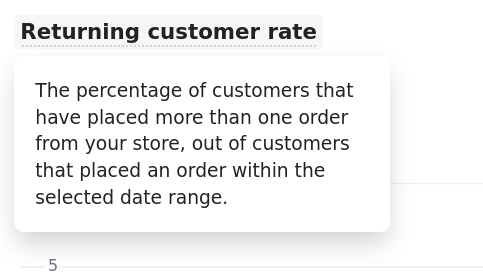Repeat Customer Insights has a new metric being tracked now.
Returning Customer Rate: Percentage of customers who have placed their second or later order in this time period, with their first order placed anytime.
This metric was a bit controversial.
In the majority of the industry, Returning Customer Rate and Repeat Purchase Rate are just synonyms. Repeat Purchase Rate measures customers who have placed 2+ orders within a time period.
But Shopify has been defining Returning Customer Rate differently:
The percentage of customers that have placed more than one order from your store, out of customers that placed an order within the selected date range.

The difference is that Shopify's version looks back outside of a report's date range and thus can find more repeat customers than there actually were. This leads to the store thinking more customers were coming back than reality.
Using Shopify's Returning Customer Rate in places where the true Repeat Purchase Rate should be used will lead to poor results and missed expectations.
(I've even found a new calculation bug in their new reports where they aren't even measuring the data correctly. It was off by over 20% in a test store, where 20% means the difference between a healthy business and bankrupt one)
Trying to get Shopify to change is a Sisyphean task sometimes.
Since I can't beat them, I might as well join them...
Now Repeat Customer Insights will include both the industry-standard Repeat Purchase Rate as well as Shopify's Returning Customer Rate. The app makes a clear distinction between the two so I'm hopeful they can each be used in the correct contexts.
If you're already using the app, you'll find the Returning Customer Rate on the Store Analysis report right below the Repeat Purchase Rate. It includes date filtering, acquisition source filtering, and graphs like many of the other metrics already in the app.
If you aren't using the app, why not give it a try? There's a 14 day trial and the Store Analysis is included with all accounts.
Eric Davis
Get a snapshot of your customer behavior
The sooner you signup for Repeat Customer Insights, the more comparison points your store will have. Each 1st of a the month a new snapshot is taken and saved to your account for analysis.